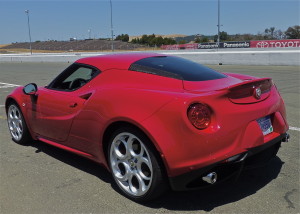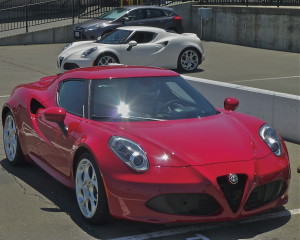Alfa Romeo Rides Exotic 4C Back Into U.S.
Filed under: Equinox, Autos
By John Gilbert
Every auto manufacturer wants to convince customers that its cars are fun, and exciting to drive. Then there are the Italians. Say no more. There is never a need for an Italian car-maker to suggest that his car is emotional, or exciting. It comes with the territory.
That’s the backdrop for the Alfa Romeo 4C, which Alfa Romeo plans to ride back into the U.S. auto market for 2015. We can call it a $55,000 thrill-making toy, and that’s not a rip. That’s basically what a Corvette Sting Ray is, or a Porsche Boxster S or Cayman S, or a Nissan GTR or 370Z. All are fun, and describe the genre, and all cost substantially more than $55,000. When you build a specialty sports car, you can charge a lot, but you’d better back it up with substance.
The 4C has, for substance: mid-engine balance, an extremely light (2,400-pound) mass that can be hurled 0-60 in the mid-4-second range, a top speed of 160 mph, an over-achieving aluminum 1,750 cc. turbocharged and direct-injected 4-cylinder, light and precise suspension and steering, and a high-tech body that owes its construction and heritage to contemporary Formula 1 technology.
The look and the performance rank in the exotic supercar class, but if that’s not enough, Alfa is going to build in an exclusivity. Only 1,000 Alfa Romeo 4C cars will be distributed to anxious U.S. buyers in its first year, through selected Fiat dealerships. One of the 4C models I drove listed for $58,295 with racing exhaust and bi-xenon headlights.

Race track setting proves designer Lorenzo Ramaciotti brought the 4C contours and emotional flair all together.
If you’re unconvinced that the 4C is emotional, and fun to drive, standing next to one is pretty good evidence of the former and starting the engine is convincing of the latter. The sound is exhilarating. It resembles the “sports-plus” settings for straight-through exhausts on Porsches or the new Corvette. The sound is part of the overall image, but it’s best experienced somewhere like the road-racing circuit at Sonoma, California, which used to be known as Sears Point.
Shift the twin-clutch direct-sequential gearbox into first and pull out of the pit lane. The steering feels just a bit heavy at first, but that’s because Alfa chose not to waste any energy on power steering. Once rolling, the light-front 4C steering is perfect, as is its precision. Build a little speed, as you exit the pits, and ease slightly up the slope toward Turn 1. Hammer it, and the sound gets better, and its reflexes seem to improve as well. The fantastic responses of the car react to every tiny steering, curving, braking or accelerating input you choose, and they conspire to create a sensory deadlock: It is impossible to calculate which is the best characteristic of just how emotional and exciting the Alfa 4C is. Read more



 John Gilbert is a lifetime Minnesotan and career journalist, specializing in cars and sports during and since spending 30 years at the Minneapolis Tribune, now the Star Tribune. More recently, he has continued translating the high-tech world of autos and sharing his passionate insights as a freelance writer/photographer/broadcaster. A member of the prestigious North American Car and Truck of the Year jury since 1993. John can be heard Monday-Friday from 9-11am on 610 KDAL(www.kdal610.com) on the "John Gilbert Show," and writes a column in the Duluth Reader.
John Gilbert is a lifetime Minnesotan and career journalist, specializing in cars and sports during and since spending 30 years at the Minneapolis Tribune, now the Star Tribune. More recently, he has continued translating the high-tech world of autos and sharing his passionate insights as a freelance writer/photographer/broadcaster. A member of the prestigious North American Car and Truck of the Year jury since 1993. John can be heard Monday-Friday from 9-11am on 610 KDAL(www.kdal610.com) on the "John Gilbert Show," and writes a column in the Duluth Reader.